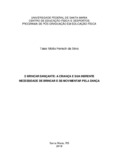| dc.creator | Silva, Taise Motta Rensch da | |
| dc.date.accessioned | 2018-11-21T20:28:04Z | |
| dc.date.available | 2018-11-21T20:28:04Z | |
| dc.date.issued | 2018-08-03 | |
| dc.identifier.uri | http://repositorio.ufsm.br/handle/1/14887 | |
| dc.description.abstract | This study aimed essentially to know children better, to understand the world of life and the world of movement, their play and move-yourself in times of technology and lack of time to be a child. Some issues were taken into consideration: does the child still have time to play and move-yourself freely? What are your possibilities for jokes? And your involvement with the new technologies? Therefore, it is necessary to place the child in the various historical processes, bringing a little about the history of the child, the emergence of day care centers and physical education in Early Childhood Education. Thus, the objective of the research is: to investigate in literature the daily oppression of children to become productive adults, and the possibility of gradual loss of one of their vital needs, which is to play and move-yourself freely and fully, and if a "dancing play" can rescue and reintroduce the child in this world of play and move-yourself. This research was done through a theoretical research, in order to dialogue about authors and new knowledge. The work presents fundamentals with some critics about play of the child who does not have time to play and move-yourself in the present day, and is being inserted early in childhood education institutions, speeding its development to the adult world. The intention is not to solve this problem, but make an alert for adults, teachers and children's institutions, and to take more into account the Child Being in its essence, valuing its potentialities and possibilities, through play and move-yourself that can be introduced or reintroduced through a "dancing play". | eng |
| dc.language | por | por |
| dc.publisher | Universidade Federal de Santa Maria | por |
| dc.rights | Attribution-NonCommercial-NoDerivatives 4.0 International | * |
| dc.rights.uri | http://creativecommons.org/licenses/by-nc-nd/4.0/ | * |
| dc.subject | Criança | por |
| dc.subject | Brincar e se-movimentar | por |
| dc.subject | Brincar dançante | por |
| dc.subject | Child | eng |
| dc.subject | Play and move-yourself | eng |
| dc.subject | Dancing play | eng |
| dc.title | O brincar dançante: a criança e sua inerente necessidade de brincar e se-movimentar pela dança | por |
| dc.title.alternative | The dancing play: the child and its inherent need to play and move-yourself through dance | eng |
| dc.type | Dissertação | por |
| dc.description.resumo | Este estudo se propôs essencialmente conhecer melhor as crianças, compreender o mundo de vida e o mundo de movimento, seu brincar e se-movimentar em tempos de tecnologias e falta de tempo de Ser Criança. Algumas questões foram levadas em consideração: a criança ainda tem tempo para brincar e se-movimentar livremente? Quais as suas possibilidades de brincadeiras? E seu envolvimento com as novas tecnologias? Para tanto, é necessário situar a criança nos diversos processos históricos, trazendo um pouco sobre a história da criança, surgimento das creches e a educação física na Educação Infantil. Sendo assim, o objetivo da pesquisa é: investigar, pela literatura, a opressão cotidiana de crianças para se tornarem adultos produtivos, e a possibilidade de perda gradativa de uma de suas necessidades vitais que é o brincar e se-movimentar de forma mais livre e plena, e se um “brincar dançante” poderá resgatar e reintroduzir a criança nesse mundo do brincar e se-movimentar. Esta investigação foi feita por meio de uma Pesquisa Teórica, a fim de dialogar com diversos autores sobre o tema e produzir novos conhecimentos. O trabalho apresenta fundamentos com algumas críticas sobre o brincar da criança que não possui tempo para brincar e se-movimentar nos dias de hoje, e está sendo inserida precocemente em instituições de ensino infantil, apressando seu desenvolvimento para o mundo dos adultos. A intenção não é solucionar esse problema, mas sim fazer um alerta para adultos, professores e instituições infantis, e levar mais em consideração o Ser Criança na sua essência, valorizando suas potencialidades e possibilidades, por meio do brincar e se-movimentar que pode ser introduzido ou reintroduzido através de um “brincar dançante”. | por |
| dc.contributor.advisor1 | Kunz, Elenor | |
| dc.contributor.advisor1Lattes | http://lattes.cnpq.br/0451631464832830 | por |
| dc.contributor.referee1 | Costa, Andrize Ramires | |
| dc.contributor.referee1Lattes | http://lattes.cnpq.br/5235035547859308 | por |
| dc.contributor.referee2 | Sawitzki, Rosalvo Luis | |
| dc.contributor.referee2Lattes | http://lattes.cnpq.br/0185565372906256 | por |
| dc.creator.Lattes | http://lattes.cnpq.br/6137406320593201 | por |
| dc.publisher.country | Brasil | por |
| dc.publisher.department | Educação Física | por |
| dc.publisher.initials | UFSM | por |
| dc.publisher.program | Programa de Pós-Graduação em Educação Física | por |
| dc.subject.cnpq | CNPQ::CIENCIAS DA SAUDE::EDUCACAO FISICA | por |
| dc.publisher.unidade | Centro de Educação Física e Desportos | por |



